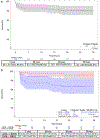Thirty-Year Survival After Cardiac Surgery in Children With Williams-Beuren Syndrome (from the Pediatric Cardiac Care Consortium Study)
- PMID: 36459747
- PMCID: PMC10198610
- DOI: 10.1016/j.amjcard.2022.10.037
Thirty-Year Survival After Cardiac Surgery in Children With Williams-Beuren Syndrome (from the Pediatric Cardiac Care Consortium Study)
Abstract
Williams-Beuren syndrome (WBS) is a genetic condition frequently requiring interventions for associated congenital heart disease (CHD). Long-term survival data after cardiac interventions for children with WBS are sparse. This is a retrospective cohort study aiming to describe the 30-year survival outcomes of children with WBS after interventions for CHD using the Pediatric Cardiac Care Consortium (PCCC), a large North American-based registry of interventions for pediatric heart diseases, between 1982 and 2009. Outcomes were obtained from the PCCC and by linkage with the National Death Index through 2020. Survival of patients with WBS and their major subgroups was assessed by Kaplan-Meier survival curves and Cox regression. A total of 200 patients met the inclusion criteria of having their first intervention for CHD at a US PCCC center and age <21 years at time of intervention. The most common lesions were left heart obstructive lesions (LHOL), either in isolation (37%) or in combination with right heart obstructive lesions (RHOL) (49.0%), whereas isolated RHOL accounted for 11% of the total. The first procedure was surgery for 85.5% of the group, and the remainder underwent a transcatheter procedure. There were 5 in-hospital deaths (2.5%), and among survivors to hospital discharge, 164 had sufficient identifiers for National Death Index linkage. Over a median period of postdischarge follow-up of 23.7 years (interquartile range 18.7 to 27.3), 16 deaths occurred, with an overall 30-year survival rate of 90%. Survival rates ranged from 96.1% for isolated LHOL or RHOL to 83.4% for patients with combined disease (adjusted hazard ratio 4.7, 95% confidence intervals 1.35 to 16.59).
Copyright © 2022 Elsevier Inc. All rights reserved.
Conflict of interest statement
Disclosures
The authors have no conflicts of interest to declare.
Figures


Similar articles
-
Long-term Outcomes After Surgical Intervention for Congenital Supravalvar Aortic Stenosis in Children.Ann Thorac Surg. 2024 May;117(5):965-972. doi: 10.1016/j.athoracsur.2024.01.020. Epub 2024 Jan 30. Ann Thorac Surg. 2024. PMID: 38302053 Free PMC article.
-
Thirty-Year Survival after Cardiac Surgery for Patients with Turner Syndrome.J Pediatr. 2021 Dec;239:187-192.e1. doi: 10.1016/j.jpeds.2021.08.034. Epub 2021 Aug 24. J Pediatr. 2021. PMID: 34450123 Free PMC article.
-
Postoperative and long-term outcomes in children with Trisomy 21 and single ventricle palliation.Congenit Heart Dis. 2019 Sep;14(5):854-863. doi: 10.1111/chd.12823. Epub 2019 Jul 22. Congenit Heart Dis. 2019. PMID: 31332952 Free PMC article.
-
Severe left main coronary artery stenosis with abnormal branching pattern in a patient with mild supravalvar aortic stenosis and Williams-Beuren syndrome.Congenit Heart Dis. 2014 May-Jun;9(3):E85-9. doi: 10.1111/chd.12087. Epub 2013 May 22. Congenit Heart Dis. 2014. PMID: 23701710 Review.
-
Risk of sudden death in the Williams-Beuren syndrome.Am J Med Genet A. 2004 Jun 15;127A(3):234-7. doi: 10.1002/ajmg.a.30012. Am J Med Genet A. 2004. PMID: 15150772 Review.
Cited by
-
Fetal Diagnosis of Supravalvular Aortic Stenosis and Pulmonary Stenosis in a Family with Non-Syndromic Elastin Mutation.Pediatr Cardiol. 2024 Jun;45(5):1154-1156. doi: 10.1007/s00246-024-03418-8. Epub 2024 Jan 31. Pediatr Cardiol. 2024. PMID: 38294523
-
Long-term Outcomes After Surgical Intervention for Congenital Supravalvar Aortic Stenosis in Children.Ann Thorac Surg. 2024 May;117(5):965-972. doi: 10.1016/j.athoracsur.2024.01.020. Epub 2024 Jan 30. Ann Thorac Surg. 2024. PMID: 38302053 Free PMC article.
References
-
- Pober BR. Williams–Beuren syndrome. N Engl J Med 2010;362: 239–252. - PubMed
-
- Collins RT. Cardiovascular disease in Williams syndrome. Circulation 2013;127:2125–2134. - PubMed
-
- Strømme P, Bjørnstad PG, Ramstad K. Prevalence estimation of Williams syndrome. J Child Neurol 2002;17:269–271. - PubMed
-
- Francke U Williams-Beuren syndrome: genes and mechanisms. Hum Mol Genet 1999;8:1947–1954. - PubMed
Publication types
MeSH terms
Grants and funding
LinkOut - more resources
Full Text Sources
Medical
Miscellaneous

